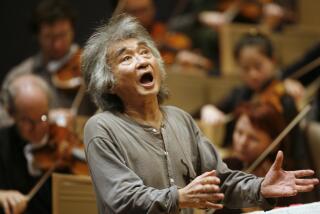Dance Review : Bando Mitsuhiro Kai Program
- Share via
The 20th anniversary program by Bando Mitsuhiro Kai began auspiciously in the Japan America Theatre Saturday night with Mitsujiro and Hideko Bando (distinguished guests from Japan) joining Mitsuhiro Bando in the ceremonial “Shiki Sanbaso.” Here the meticulous technical control and expressive purity of Japanese classical dancing were evident in each tiny inclination of the head, every formal deployment of sleeve or fan.
The performance ended, some three and a half hours later, with “Gion No Yozakura,” in which one sober, gestural duet by Hirochizu and Hiroteru Bando distilled the exquisite stylization of womanhood at the heart of the eight-part program.
Grand Kabuki is, of course, an all-male art--but Kabuki concert dance glories in its women. Indeed, this showcase for the dance school that Mitsuhiro Bando founded 20 years ago in East Los Angeles managed to include one piece dramatizing female superiority (“Onna Date,” with Yukiko Sasaki triumphing in formalized combat with Kanjiro and Kiyoshi Bando) and one feminized version of a Grand Kabuki masterwork.
Usually, “Renjishi” shows a father lion educating his son. In their first scene, lionhood is presented obliquely but later the characters reappear to prowl the stage wearing eight-foot-long manes.
On Saturday, however, Hideko Bando portrayed a mother lion opposite a high school student from Torrance who was granted the stage name of Hidesomi Bando only this April. Thus the imitative and instructional action of their duet assumed a new significance. And if the spectacular mane-swirling that forms the climax of “Renjishi” was missing, Hideko Bando’s powerful dramatic focus gave each stamp and head-toss true leonine majesty.
Dances celebrating different types of flowers and different types of women completed the program--many featuring younger members of the Bando Mitsuhiro Kai. Taped music accompanied the dancing.
More to Read
The biggest entertainment stories
Get our big stories about Hollywood, film, television, music, arts, culture and more right in your inbox as soon as they publish.
You may occasionally receive promotional content from the Los Angeles Times.










